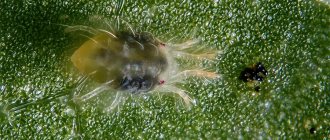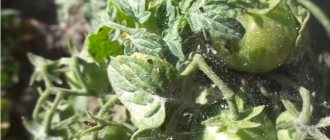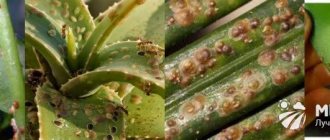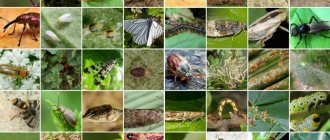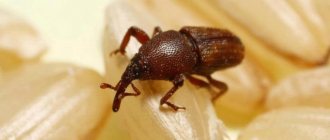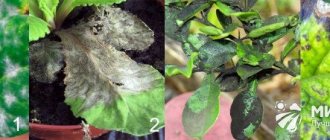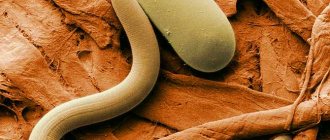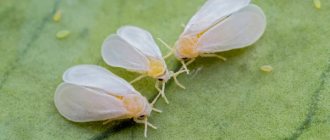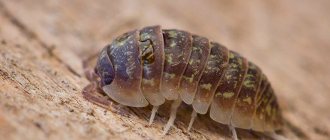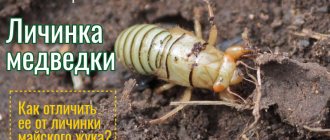General information
Various insects are the main pests of coniferous trees in the garden. There are always a lot of them, and they are so voracious that measures to combat them must be taken immediately. They are rarely limited to one plant and usually attack all similar plants with epidemic speed, which can lead to the death of the plant.
Harm
What conifer pests can do:
- nibble or even completely eat the needles;
- suck the juice out of it, causing it to turn yellow and crumble;
- damage the bark, and then the trunk itself;
- settle in the roots and feed on them.
Almost from the very first days of the invasion, plants lose their attractive appearance. They are crawling with caterpillars, or they are covered with fluff, saliva or cobwebs. Then the needles begin to turn yellow and crumble, and whole pieces of bark fall off. As a result, if no control measures are taken, inevitable death occurs. At the same time, as mentioned above, the epidemic will spread to other similar trees and shrubs.
Classification
The degree of damage and the speed of spread of insects will largely depend on what kind of pests attacked the garden. There are several classifications. For example, one that is based on a biological species:
- weevils;
- goldfish;
- mites, bugs, cocoon moths, root beetles, bark beetles;
- leaf rollers, pine beetles;
- moth;
- moths;
- sawflies, shoots, grasshoppers, moths;
- horntails;
- tars, scoops;
- aphids;
- barbel;
- hermes;
- silkworms;
- Scale insects.
These are the most common families of insects that are the main pests of conifers. However, within them there are also subfamilies, the names of which often indicate the main object of their destruction. For example:
- pine weevil;
- spruce woodcutter;
- spruce and pine bug;
- pine cocoon moth;
- larch leaf roller;
- juniper, spruce, larch moths;
- larch, juniper, spruce, pine sawfly;
- fir and pine moth;
- spruce, juniper, pine, thuja aphids;
- spruce and fir barbel;
- hermes spruce, pine, spruce-fir;
- cedar, pine silkworm;
- juniper and pine scale insects.
But this does not mean at all that if a larch leaf roller attacks the garden, it will only destroy the larch. Yes, first of all it will destroy all the trees of this species, but then it can start attacking others. So the names of the subfamilies are quite arbitrary. The second classification is based on the method of destroying conifers:
- sucking - sucking juices from various parts of a coniferous plant (scale insects, aphids, mites, hermes);
- needle-eaters - eating buds and needles (weevils, sawflies, cutworms, moths);
- cone beetles - damaging cones (pine cone moth, cone moth, pine cone moth);
- trunk beetles - feeding on bark and intra-trunk contents (bark beetles, pine beetles, longhorn beetles, woodcutters);
- root beetles - destroying the roots of coniferous plants (spruce root aphids, root aphids).
As for the classification depending on the orders of insects, these are mainly butterflies and beetles, as well as their larvae and caterpillars.
How to fight
The main control of coniferous pests is carried out using chemical insecticides. They are sold in different forms: as an emulsion concentrate (Prestige KS), water-dispersible granules (Decis Profi), powders (Pinocid), sprays (Magtoxin). When choosing a drug, you should take into account the nature of their effect on pests:
- universal - against several types of insects (for example, Pinotsid protects against hermes, aphids, scale insects, sawflies, leaf rollers);
- acaricides - against ticks (Kleschevit, Nissoran);
- aphicides - against aphids (Biotlin);
- larvicides - destruction of larvae, caterpillars (Iskra, Lepidotsid, ExtraFlor);
- ovicides - getting rid of clutches of insect eggs (Preparation 30 Plus);
- repellents - scarers, used for prevention (Soil, pheromone traps).
Photos of drugs:
It is also useful for gardeners to know that there are natural insecticides. Some plants repel insects with their scent. As a preventive measure, to protect the garden from pest invasion, they can be planted near conifers:
- garden insecticides: garlic, onions, horseradish, cumin, celery, fennel, potatoes, basil, hot peppers, mustard, dill, parsley, tomatoes;
- flowering insecticides: marigolds, calendula, matthiola, nasturtiums, chrysanthemums, petunias, lovage, pelargonium, sage;
- wild insecticidal plants: wormwood, spurge, celandine, elderberry, tansy, tobacco, bird cherry, yarrow, burdock, larkspur.
The first treatment of plants against coniferous pests is carried out in the spring and is preventive in nature. During the summer, it is also recommended not to forget to spray them with insecticides at least once a month. This is a great way to prevent insect infestations, because fighting them is extremely difficult and unpleasant.
Pine and its pests
Various types of pine trees are very popular in garden plots. These beautiful evergreens have a healing aroma and are pleasing to the eye all year round. But despite the external power and grandeur, many different types of pests develop on pine trees: insects that feed on pine needles, as well as the most dangerous ones, which feed mainly on shoots, trunks and roots. Trees growing near a pine forest, where a large number of pests live that can easily move to your pines, are at particular risk. Of the insects that feed on needles, it is necessary to pay attention to sucking pests. They are small, often invisible, but their development significantly weakens the tree, making it easy prey for bark beetles. Large insects feeding openly on needles are easy to detect. For example, a beautiful caterpillar - the pine hawk moth. These insects are usually observed in small numbers, so they can be easily collected by hand, especially if the pine trees are small. Lately, sawflies have been causing great harm to mountain pine, settling on them more readily than on Scots pine. From the beginning of May, carefully examine pine needles for sawfly nests. If detected in a timely manner, they can be removed manually or treated with Decis, Karate, and Bliskavka. The greatest danger is posed by insects that can easily cause plants to die - these are root pests, primarily May beetles. Khrushchev is especially dangerous for young pines, so when planting, carefully scan the ground for the presence of larvae. If their quantity is more than 3 pcs. per 1 sq. m, planting should be stopped or a global treatment of the soil should be carried out with preparations to destroy beetles. More than once I had to observe the withered trunks of Crimean pines after the development of six-toothed bark beetles in them, which are present in pine forests and settle on diseased or dead trees. The risk group also includes recently transplanted young trees, which during this period are physiologically weakened, which attracts bark beetles. When settling on pine trees, bark beetles make tunnels and ring the tree, as a result, the trunk does not receive enough nutrients and the plant dies. Therefore, it is necessary to periodically inspect newly planted pines for bark beetle colonies, especially in the spring. Signs of the introduction of bark beetles are holes and drill flour on the trunk. It is good to carry out preventive treatment of pine trees at the end of March - April with preparations based on bifenthrin. Remember that with timely detection of pests and proper implementation of protective measures, you will preserve the health of your pine trees for many years. Insects that damage needles Pine silkworm (Dendrolimus pini) A dangerous pest of Scots pine that can develop on Crimean and mountain pine. Butterflies with a wingspan in females from 5 to 9 cm, in males - 4-7 cm. The general color of the wings is the color of pine bark, very variable - sometimes more gray, sometimes more red. Butterfly years are from the end of June to July. Females lay about 200 round, rather large eggs in heaps on pine branches, on pine needles and bark. The caterpillars emerge after 15-20 days, usually in early August. Caterpillars are hairy, gray or dirty reddish, the color of pine bark, adults - up to 9 cm in length; feed until the onset of frost, then go to the litter for the winter. In early spring, the caterpillars rise into the crown and begin intensive feeding, sometimes completely eating the needles from the tree. One caterpillar can eat up to 700-800 needles during the development period. In June-July they complete development and pupate in loose cocoons attached to the branches. Control measures: treatment in the fall or spring with Decis, Karate, Aktara, Enzhio, etc. Red pine sawfly (Neodiprion sertifer) is especially harmful to Scots, Crimean and mountain pine, eating their needles. Damaged trees weaken, lose their decorative properties, reduce growth, die down and are colonized by bark beetles. The female is red, 7-8 mm long, yellowish wings. The male is black, 6-7 mm in length. The sawfly larva is a false caterpillar, greenish-gray, with a narrow, lighter stripe along the back and a black head. The hatching of larvae occurs simultaneously with the flowering of Scots pine. The larvae live in groups (nests) of 20-30 individuals or more, feeding on needles from previous years. Pseudo-caterpillars of the first and second instars eat only the soft tissues of the needles and do not touch the vascular-fibrous bundles. As a result, the needles curl and dry out, forming brown spots that are clearly visible against the background of the green crown of the pine tree. It is worth paying attention to the appearance of branches with dry, twisted needles in order to destroy the pest in time. When older larvae feed, only “stumps” remain from the needles. In June, the larvae cocoon in the litter under trees. In August-September, adults emerge and lay eggs in annual needles. Control measures: pyrethroid drugs - Decis, Karate, Bliskavka, etc., as well as viral drugs, have a good effect on the pest. If the pines are small, the larvae can be collected by hand and destroyed. Common pine sawfly (Diprion pini) A dangerous pest of pine trees, the reproduction of which affects not only last year's needles, but also the current year's needles, which significantly affects the viability of trees. It eats the needles of pine trees, especially common, mountain, and Crimean ones. Adult female of variable color, 7.5-10.5 mm long. The male is black, with yellow legs, 5.5-8 mm long. Two generations develop per year. The first generation's years begin at the end of April. The summer generation occurs in midsummer. The female lays about 100-150 eggs in the needles. In the spring, females lay eggs only in old needles, in the summer - in the needles of the current and previous years. The larvae of the first three instars gnaw the needles, leaving the central part untouched, causing them to dry out and curl. Adult larvae eat the needles completely. The larvae pupate in a barrel-shaped cocoon, which are located on the branches in the spring generation, and in the litter in the autumn generation. Control measures: treating the larvae with Decis, Karate, Aktara, etc. On small trees, the pest can be collected by hand. Red-headed or social weaver sawfly (Acantholyda erythrocephala) Develops primarily on Scots pine, but is also noted on Weymouth pine. Adult insects have a blue body with a metallic sheen. The length of the female is 12-14 mm, the head is red. Male – 10-12 mm, black head. The adult years begin in the last ten days of April and last until June. Eggs are laid in rows on last year's needles. The larvae live in large web-like nests that contain excrement and remains of pine needles. The larvae of the last instars live individually. At the end of June, the larvae descend into the litter and pupate in cocoons. Control measures: treatment with Decis, Karate, Aktara, Enzhio. Pine hawkmoth (Hyloicus pinastri) Damages the needles of Scots and Crimean pines. The butterfly is large, gray, with narrow, long wings 6.5-8 cm in span. Flies in May-June. The female lays up to 200 eggs singly on needles. The caterpillars appear at the end of June – July, develop for about 1 month, and feed on pine needles. An adult caterpillar is 6.5-8 cm long. The body color is variable, mostly green, with a black-brown horn at the rear end of the body. Caterpillars pupate on the forest floor. The pupae overwinter. It does not produce outbreaks of mass reproduction, but sometimes it significantly damages pine needles. Control measures: caterpillars can be collected by hand or the pine trees can be treated with insecticides. Pine armyworm (Panolis flammea) Damages the needles of Scots pine and can feed on the needles of other pine species. The butterflies are reddish or greenish-brown, matching the color of pine buds that have begun to grow. The wingspan is 2.5-3.5 cm. The caterpillar is green, with five white stripes and a lateral orange stripe above the legs. The butterfly flight begins at the end of March - April, in colder years it can last until the end of May. They fly at dusk. Females lay 2-10 eggs on the underside of pine needles, sometimes more. After about 14 days, caterpillars emerge from the eggs and eat the tops of the budding young needles, which is very dangerous for the viability of the pines. Older caterpillars eat the entire needles. After 4-5 weeks of feeding, usually at the end of June, the caterpillars descend to the soil and pupate on the forest floor. Control measures: treatment with Decis, Karate, Aktara, Enzhio. Pine moth (Bupalus piniarius) Damages the needles of Scots, mountain, and Crimean pine. The butterfly has a wingspan of 30-40 mm. The male's wings are dark brown and his antennae are feathery. The female has reddish-brown fore and hind wings, and thread-like antennae. Butterflies usually fly at the end of June. Females lay eggs in rows on the underside of old pine needles (from 4 to 7 pieces in one row). After about 14 days, caterpillars emerge from the eggs. The adult caterpillar is grayish-green, with five longitudinal white stripes, up to 30 mm long. They begin to eat needles from the top and from the outside of the crown. The needles are eaten completely, leaving only the middle rib. Resin appears on the needles, the needles turn yellow and fall off. Caterpillars complete development in late summer or early autumn. Pupation usually takes place in October in the litter or soil. Control measures: treatment with Decis, Karate, Aktara, Enzhio. Sucking pests Pine beetle bug (Aradus cinnamomeus) Severely damages pine trees by sucking their tissue, which leads to weakening of the trees. An adult female is 4.5-5 mm long, the body is flat, rusty-brown in color, the color of pine bark. Females of two forms are observed: long-winged and short-winged. The length of the male is 3.5-4 mm. The larva resembles an adult insect, but is smaller in size and has shorter antennae. Bedbugs have a specific odor of pear essence. Fourth instar larvae and adults overwinter in the litter around the trunk or in bark cracks in the lower part of the trunk. In early spring, bugs climb up the trunk and begin to feed and reproduce. During this period, you can apply glue rings or tape to the trunks, this will help to detect and destroy them. A sign of the colonization of pine trees by the subbark bug is the appearance of yellowish and then brown spots on the trunks. Subsequently, the bark cracks and resin deposits form on it. The color of the needles also changes, they become dull and pale, the May growth falls off, and the shoots shorten. Control measures: effective treatment of trunks and near-trunk part of the litter, in autumn or early spring, with systemic preparations Enzhio, Confidor, Mospilan, etc. Brown pine aphid (Cinara pinea) Feeds on plant sap. In the spring they settle in dense, large colonies mainly on young shoots and needles of the current year, and in the summer they move to thicker branches, where they can reproduce in large numbers. The body of aphids is thick, dark or brownish with a shine. Winged individuals are as common as wingless ones. In autumn, females crawl onto annual shoots, where they lay large, dark, fertilized eggs in rows. The development of the foundresses from eggs occurs in late April - early May, always accompanied by Lasius niger ants. Control measures: treatment with Calypso, Confidor Maxi, Mospilan, etc. Spindle pine scale (Anamaspis lowi) Peculiar insects, often found on almost all pine trees grown in Ukraine. Larvae and females feed on needles. At the site of sucking, the needles turn yellow and die, which can cause them to fall and significantly weaken the trees. The body of females is covered with a shield; they lead a sedentary lifestyle, only sucking juices and laying eggs. The female's scutellum is elongated, white, widening towards the end. The size of a female with clutch is about 2 mm. Females and larvae overwinter. Overwintered scale insects feed and lay eggs from spring to autumn. The larvae of the new generation appear in May, they are mobile and are called wanderers. Having emerged from the eggs, they actively disperse throughout the plants. Control measures: treatment with Calypso, Confidor Maxi, Mospilan, etc. Pine hermes (Pineus pini) Damages Scots pine, Weymouth, and cedar. Hermes are peculiar aphids that develop only on coniferous plants and suck their juices. On the needles of infested pine trees, you can find small reddish-brown aphids covered with white, waxy, curled hairs. The development cycle of Hermes is complex. It produces 3-4 asexual generations per year. The larvae overwinter and in the spring they turn into oviparous founders. From the eggs laid by the founders, virgin larvae emerge, which, having reached maturity, lay unfertilized eggs, giving rise to a new partogenetic generation. Sometimes winged dispersers appear and form colonies on other trees. If there are spruce trees nearby, development may occur on another host, where the larvae develop in galls. Control measures: treatment with Calypso, Confidor Maxi, Mospilan, etc. Red pine gall midge (Thecodiplosis brachyntera) Adult gall midge is a small dipterous insect, up to 2.5-3 mm, brown in color. The female with a long ovipositor lays up to 100-120 eggs, one at a time or 2-3 eggs at a time. at the base of young needles. The larva is at first colorless, later (in September) it is brightly colored orange-yellow-red. The development of larvae leads to the fusion of a pair of needles at the base. The site of development of the larva expands and swells, forming a gall 2-3 mm in size. Damaged needles are always noticeably shorter. In autumn, the larvae's feeding ends, and they go to winter under the scales of the shoot. The larvae pupate in the spring in a small whitish-gray cocoon 2-3 mm long. The age of adult gall midges is in May. Control measures: treatment of needles with Enzhio, Aktara, Mospilan, Calypso. Insects that damage needles, shoots, roots Gray pine weevil (Brachyderes incanus) A beetle 7-11 mm long. The beetles overwinter under bark, moss and in the soil. In the spring they begin to feed, gnawing the needles and bark of young shoots, attacking mainly young, 8-15 year old pines. In May they begin to lay eggs in the soil. The larvae feed on the roots of pine trees, gnawing the bark of thin and thick roots, severely damaging them, which is especially dangerous for young trees, as it can cause their death. The larvae pupate in late summer, and soon the beetles emerge to the surface. Spot tar (Pissodes notatus) is especially harmful in pure pine plantings or pine trees growing in areas located in or near pine forests. Beetle 5-7 mm long. The summer of beetles is in May-June. With additional feeding, beetles damage the needles, bark of shoots and branches, gnawing out areas in it that are often covered in resin. Females lay several eggs in a pre-prepared area gnawed into the bark. The larvae are legless, sickle-shaped. Each larva gnaws its own individual passage. The larvae and their passages are located in the lower part of the trunks and root collar, on the root paws of young pine trees 3-20 years old. The beetles usually overwinter on the forest floor and under the bark of old stumps, and begin breeding in the spring. The generation is annual. The beetles undergo additional feeding. Control measures: treatment of infected trees with drugs Caesar, Talstar and others based on bifenthrin. Large pine weevil (Hylobius abietis) A dangerous pest of Scots pine and Weymouth, it can damage spruce, larch and fir trees. Beetle 10-13 mm long. Adult beetles usually fly from May to June and then lay eggs - in cracks in the bark, under root nodes or at the ends of chopped roots. After 2-3 weeks, larvae appear, burrow into the ground and develop under the bark of the root part of the stumps. The larva is whitish, legless, slightly C-shaped. The body length of the last instar larvae is 12-23 mm. The pupal stage lasts 2-3 weeks. The greatest harm is caused by adult beetles, which gnaw the bark and bast of young trees and can completely ring them, leading to death. Control measures: treatment with Aktara, Enzhio, Mospilan, Calypso. Shooters are butterflies from the family of leafrollers (Tortricidae), whose caterpillars damage the buds and young shoots of various types of pine trees. As a result of feeding on the contents of the buds and tissues of growing shoots, curvature of the trunks and multi-vertexing occur. This leads to loss of decorative properties and a decrease in the industrial value of wood. Trees between 3 and 15 years old are usually damaged. The most common are: wintering shooter (Rhyacionia buoliana), summer (Rhyacionia duplana), tar shooter (Retinia resinella), bud shooter (Blastesthia turionana). These types are distinguished by the nature of the damage. Wintering shootweed (Rhyacionia buoliana) Prefers to develop on Scots pine; Crimean, Weymouth and other types of pines are more resistant to the pest. The butterfly has a wingspan of 18-24 mm. The forewings are orange, with several transverse silver stripes. Summer begins in the second half of June and lasts about a month. Females lay eggs on the buds of the apical shoot. In August, the caterpillar bites into a kidney, where it overwinters. On damaged buds, a characteristic cobweb is visible that covers the caterpillars. The adult caterpillar is dirty-waxy in color, no more than 21 mm long. Since spring, the caterpillar continues to damage the bud and the lower part of the growing shoot. This is when it does the most damage. Pupation occurs in June in a damaged shoot, which later dries out and bends downwards. Pupation usually begins in late May - early June. After 15-20 days the butterflies fly out. The Summer Summer (Rhyacionia Duplana) butterfly in the wingspan of 13-20 mm. The front wings from the dark gray at the base to a rusty color with a golden tint at the top. Years of butterflies-in April-May. Females lay eggs usually on last year's shoots of the upper mutat near the kidneys. Caterpillars begin to leave the eggs from mid -May, bite into the May escape with green needles and eat in it, making a move from the bottom up. Damaged shoots are curved and dry. The caterpillar is light orange or yellow-pink, 9.5-13 mm long. Pupulation occurs on the root neck of pines. Most often, the tops of the shoot and then its base are damaged. A shooting bud (Blastesthia (Rhyacionia) Turionana) damages the shoots of ordinary pine. A butterfly in a wingspan is 16-20 mm. The front wings are brownish-gray, with numerous transverse strokes of light gray color. Butterflies fly in May - early June, eggs are laid on the kidneys, shoots and needles. The caterpillars abide from the first half of June to July, squeeze into the kidney and feed on its contents. During the summer, one caterpillar can damage several kidneys. The caterpillars in the kidneys winter, food continues in the spring, in May they pupate inside the damaged kidney. The caterpillar is light brown, with a black head, 13-17 mm long. The shooting man-somolent (Retinia resinella) butterfly in a wingspan of 17-23 mm. The front wings are black and brown, with numerous transverse silver-gray strokes and small spots. The rear wings are brown, darker around the edges. Years of butterflies-in May-June. Eggs are laid at the base of the mutat. The caterpillar bumps into the escape, from where the Zhivitsa protrudes, forming a false gall - Smolyana Neck. The caterpillar winters twice and pupates in a time for the third year, in the spring. Usually, after the end of development, damaged tissues overgrow, so it does not cause significant harm. Sometimes it is possible to damage the barrel throughout the circumference, as a result, the top dies, which causes a change in the shape of the crown. Struggle measures: with low infection, manual collection and destruction of damage along with caterpillars and dolls of pests is possible. For wintering and summer shoots, this should be done no later than mid -June. In case of chemical struggle, the use of Aktar insecticides, Mospilan, Confidor, Calypso, it is advisable to use them at the beginning of the abstraction of caterpillars. Large stem pests (Tomicus Piniperda) and a small (Tomicus minor) pine luboists damage the rays of patients and weakened pines. The intensive settlement of weakened trees with rays can lead them to death. With additional nutrition, beetles cut off the apical shoots of pines, which also weakens the plants. Both species are widespread, a large pine luboed is more common in more humid areas of the forest. Beetles are brown, difficult to distinguishable in appearance, the size of a large pine lubbed-3.5-5.2 mm, small pine lubbed-3.4-4.5 mm. Yukov’s years happens very early, immediately after the melting of snow. Beetles rush holes mainly in the lower part of the bark in young pines and lay eggs. The larvae are white, small, make the moves in the Luba, with a high density of larvae, pine trees can ring, as a result of which they die. Control measures and prevention: the processing of transplanted trees, especially planted near large pine massifs, Caesar, Talstar, Balazo and others based on bifentrin. Prevention is carried out in March - early April, to monitor the appearance of the first signs of settlement with pests (holes in the trunk, drilling flour). Blue pine gold (Phaenops Cyanea) populs the trees weakened by transplanting pine trees. A beetle 8-12 mm long, dark blue with a metal tint. Years in June-July. Females lay eggs one in the cracks of the bark mainly in the middle part of the barrel. The larva is yellow-white, legless, 23-25 mm long, flattened body. Larvae gnaw under the bark of long winding moves filled with drilling flour. Larvae winter, end in the spring, in May pushes out. Measures of struggle: as with luboists. Corneed black (Hylastes ater) Black or black and brown beetles. The roots of young pines are damaged, they also develop under the bark and in the basal part of the trunk of weakened trees. The main years in April June. The uterine move is longitudinal, usually straight, occasionally oblique. The larval moves are frequent, strongly confused. Beetles usually winter. Measures of struggle: as with luboists. The six -toothed bark beetle (IPS SexDentatus) damages the pine trees of Crimean and ordinary, especially recently transplanted and weakened. Beetles are active from spring to autumn, fly in May, additional power is undergoing a bark in the moves that bite in different directions. 1-4 long (up to 40 cm, often much longer) of the uterine move from the marriage chamber up and down. Larvae moves are rare, short, rapidly expanding. Beetles winter in old moves or in the litter. In years with high summer temperatures, up to three generations can give. Control measures and prevention: the processing of transplanted trees, especially planted near large pine massifs, Caesar, Talstar, Balazo and others based on bifentrin. Preventive processing should be carried out in early April. In order to avoid the mass reproduction of bark beets and the death of the pines, carefully monitor the appearance of the first signs of settlement with pests (holes in the trunk, drilling flour). The unpretentiousness of coniferous plants is not always the key to their successful cultivation in the garden. Therefore, it is so important to use preventive measures, timely detection of pests and conduct the correct measures to combat them. * All drugs are given exclusively in reference, monitor these drugs in the official edition of Pesticidv I Agrohimativ, perpetrated to Vikoristann in Ukraine. ” the Greenmarket.com.ua online store Svetlana Gamayunova, Ph.D.
Note: a photo of a pine panel is taken here-https://dimetris.com.ua/forum/viewtopic.php?t=5389
Blot Sosnoy Leucaspis Lowi (synonyms Anamaspis Loewi; anamaspis lowi; leucodiaspis locodiaspis lowi)
RETURN TO SECTION
Weevils
Another name: elephants. Order: beetles (Coleoptera). Kinds:
- large pine;
- small pine (spot tar).
Description:
- a characteristic feature is a highly elongated head, which in botany is called the rostrum;
- body length - from 1 to 30 mm;
- color - yellow, brown, black, perhaps in some species - with spots and a metallic tint.
Signs of infection:
- invasion period - May-June;
- affect the bark and infect the plant with blueweed;
- the main symptom is small wounds on the trunks of young coniferous plants, from which resin begins to actively flow;
- the needles gradually turn red and fall off.
How to fight:
- pollination with barrier action insecticides;
- it is advisable to immediately add a fungicide to the pollination solution to prevent blue staining;
- Once there is information that pests have been spotted in the region, natural insecticidal plants can be used to repel them.
Weevils attack mainly pine, but they also do not disdain spruce and larch. Young plants are primarily at risk. If no control measures are taken, the tree dries out. If it survives, it remains ugly.
Bedbugs
Order: Hemipterans, or arthropodous. Kinds:
- spruce subbark;
- pine root.
Description:
- distinctive feature - odorous glands that secrete an unpleasant odor;
- body length - from 3 to 10 mm;
- color - most often brown, green or red, there may be spots and patterns.
Signs of plant infection:
- sticks to the trunk, breaks the integrity of the bark, sucks out juices;
- the bark begins to peel off in whole pieces;
- under it, spots are found on the trunk - gray-white, brown-red, yellowish;
- the needles turn pale, become thinner, and look painful;
- the top dries out.
How to fight:
- spraying with antiseptics: Lepidocide, Lepidobactocide, Bitoxibacillin;
- spraying with chemical insecticides: Actellik, Confidor;
- treatment of pine with Arborjet, which is injected directly into the trunk;
- spring treatment of conifers with preventive agents: Decis, Karate, Aktara, Enzhio.
Among the folk remedies for controlling such pests, the most effective is treatment with a solution of potassium soap and water, citrus fruit or tobacco infusion. Bed bugs attack mainly pine, but they also do not disdain cedar and larch. Those most at risk are trees with dried out bark, peeling plates, and a green layer of moss on the trunk.
Gray mold (rot)
This disease is caused by the fungus Botrytis cinerea and is manifested by the formation of ash-gray cobwebby mycelium on the needles. The mycelium can exist for up to 2 years and at the same time infect new parts of plants. The development of the disease occurs in the fall, and by spring the mycelium grows into the root system of young seedlings, causing tissue death and death. The disease develops especially actively in conditions of increasing humidity and thickened crops, in places where moisture accumulates and in shaded areas.
Measures to prevent and combat gray mold
|
Bark beetles
Order: beetles (Coleoptera). Some scientists consider bark beetles to be a subfamily of weevils. Kinds:
- bark beetle engraver;
- twin bark beetle;
- bark beetle typographer;
- root veins.
Description:
- body length - from 1 to 15 mm;
- the head is small, retracted;
- the color is most often dark brown or black;
- the back of the body is sloping and covered with small teeth.
Signs of plant infection:
- appear in late May-early June;
- A woodpecker regularly flies into the garden and constantly processes the same coniferous tree (bark beetles are his favorite delicacy);
- small holes in the bark;
- resin oozes from them;
- Small sawdust is found under the plant.
How to fight:
- treatment with insecticides that are injected with a syringe directly into the passages of pests: Antisheshelin, Vitalizer, Clipper, Confidor Extra, Senezh-Insa, Neomid StopZhuk;
- hang pheromone traps in the garden;
- treating trunks with manure - with clay or slaked lime;
- treating trunks with garden varnish.
For more information about control methods, see the article: Bark beetle in the garden.
Bark beetles are dangerous because they do not disdain any plantings. The same typographer especially loves conifers, but can also settle on any fruit tree. It is almost impossible to deal with rootworm. Firstly, it is difficult to detect, since it wears down the plant from below and is not visible. Secondly, in most cases it is no longer possible to restore damaged roots.
Bark beetles (Scolytinae)
A real scourge of forests. If your area with conifers is located near a forest, be careful, sooner or later the conifers will become the object of attention of this beetle. Most of them live directly under the bark of conifers, sometimes going deep into the trunk and gnawing numerous passages in the wood. The length of the beetle does not exceed 1.2 cm, and its dark color makes it inconspicuous. The female lays eggs directly into the passages she has gnawed, and the hatched larvae lay out their own “routes.” After overwintering, they move outside and begin to fly. First of all, bark beetles select sick, weak and dry trees, finally destroying them.
Measures for prevention and control of bark beetle
|
Leafrollers
Order: Lepidoptera (butterflies). Kinds:
- larch gray;
- spruce beetle;
- spruce needle beetle;
- plump fir;
- knobby.
Description:
- Butterflies have roof-shaped, elongated triangular, grayish-whitish wings;
- The caterpillars are 16-legged, covered with sparse hairs, greenish, pinkish-white or yellowish in color, with a brown or black head.
If the pest is a larch, fir or spruce leaf roller:
- defeat occurs in early July;
- on the lower branches of conifers, red, clearly visible spider nests with pest feces and dry remains of needles appear;
- insects attack mainly larch, fir and spruce.
If the pest is the pinecone leaf roller:
- caterpillars eat only fir cones;
- eats up to 90% of all cones on the tree;
- the problem is that externally infected cones are practically no different from healthy ones;
- the only sign of pests inside them is resinous secretions on the scales;
- After falling, infected cones do not open, their seeds have almost zero germination.
How to fight? Spraying with chemical insecticides is effective only at the very beginning of infection, since then they hide deep in their nests or cones, and the active substances simply do not reach them. Therefore, it is much better to focus on preventive measures, so that already at the beginning of summer pheromone houses from leaf rollers hang in the garden. There are also belt traps that are thrown onto the lower branches of trees, and in the fall they are burned along with the insects that get there.
Mechanical measures to combat pine sawfly
You can get rid of the pest using several methods, and often only their combined use can save you. Forestry measures involve the use of forests in the planting process, planting not ordinary, but Crimean pine, which is less susceptible to infection, enriching the soil with nitrogen by planting green manure, or creating mixed forests. There are biological methods and chemical preparations. The use of mechanical methods is the simplest and oldest solution, requiring neither toxic compounds nor special costs.
Special sources usually mention only one of these methods, which can be used on a summer cottage, private or country land:
- collecting larvae manually (similar to the Colorado potato beetle from potatoes, but only with the use of protective gloves and an insecticide solution into which they are thrown);
- knocking down the pest with a stream of water from a hose from the upper, hard-to-reach branches and collecting them on the surface of the ground;
- digging up the soil immediately after harvesting and for the winter so that cocoons with larvae do not overwinter.
This is an unproductive and labor-intensive method, instead of which summer residents prefer to use so-called folk remedies. These include spraying with garlic or mustard solution, tobacco or shag infusion. There are biological methods being developed by scientists. Insects are infected with viral infections, natural enemies are bred - ants, tachinas and wasps, and insectivorous birds are attracted. In a small area, you can use relatively safe biological insecticides or pheromone traps (if they can be found on sale).
The most interesting mechanical device is the hunting belt. There are two types: some are covered with a non-drying sticky compound, others are saturated with poison, which is lethal to the larvae heading into the soil to pupate.
Both products are good only if integrated pest control is carried out, because while the second generation goes to winter, it, together with the first, can destroy a huge number of needles. This does not affect the eggs laid by the adults, which will successfully hatch into a new generation of eater larvae.
pine beetles
Beetles of the weevil family and bark beetle subfamily. Kinds:
- big pine (big gardener);
- small pine (small gardener);
- southern pine.
Description:
- body length 3.5-4 mm;
- color - shiny black (brown), body covered with small gray hairs;
- light brown antennae and paws.
Signs of plant infection are similar to those observed with bark beetles, since bark beetles belong to their subfamily:
- a woodpecker settling on one of the conifers;
- holes in the bark;
- light brown sawdust under the tree;
- yellowing and subsequent falling of needles;
- resin leaks;
- peeling of the bark.
It is almost impossible to fight the pine beetle. Injecting insecticides under the bark, into the insect's passages, sometimes does not achieve its final goal, but only drives the pest even deeper. Even the powerful Karbofos cannot cope with them. It remains to either take preventive measures in a timely manner (in the spring and during the summer), or hope for the self-defense of the pines. Strong, healthy trees begin to intensively exude resin, which seals the passages of insects, and they die without air inside.
Peak beetles are one of the most dangerous pests for coniferous trees. They affect not only wood, but also bast (hence the name) - the vital tissue of the plant. Thus, the transport of water and nutrients is disrupted. This leads to dehydration, exhaustion and dryness. Fungal infections carried by these insects accelerate the death.
Main diseases of ornamental conifers
The tips of the needles begin to turn yellow for various reasons. In the spring, the bright sun causes burns and a bronze appearance appears. Common infections include fungal infections. Rust appears more often on pine, and juniper is affected. From swellings that appear on the branches, spores are transferred to currants and pears. Fusarium, cytosporosis, and phomosis are considered dangerous diseases. Thuja suffers from them. Defects appear on the bark and branches. The needles darken and fall off.
Old, unkempt trees are susceptible to diseases. There are breeds of conifers that are resistant to fungal diseases. But they are not immune from caterpillar attacks. There is only one conclusion: if you plant evergreen forest wonders on your site, study ways to combat infections and pests.
Moli
Order: Lepidoptera (butterflies). Kinds:
- juniper shoot;
- larch cap and miner.
Description:
- almost always lead a twilight lifestyle;
- distinguished by a shaggy large head;
- color - whitish-gray.
Signs of plant infection:
- usually begins in May;
- eaten needles, which moth caterpillars never completely eat, but after them they fall off;
- yellowing of needles;
- white coating on the crown and branches;
- the formation of cobweb nests in which caterpillars live.
How to fight:
- collecting and burning spider web nests;
- treatment with insecticides (Iskra, Komandor, Fufanon).
First of all, the caterpillars of this pest attack young, immature seedlings.
Sawflies
Order: Hymenoptera. Suborder: sessile bellies. Kinds:
- large larch;
- small larch;
- juniper;
- common spruce;
- common pine;
- red pine;
- green larvae (false caterpillars).
Description:
- cellular wings with venation;
- wide bridge between the chest and abdomen;
- the larvae look like caterpillars;
- the name is associated with the shape of the ovipositor in the form of a saw blade;
- gnawing mouthparts.
Signs of plant infection:
- the invasion is observed in May-early June;
- pests gnaw fresh needles: if the coniferous seedling is young, the damage can be up to 100%;
- eaten places are found primarily on the sunny side.
How to fight:
- treatment with enteric-contact insecticides: Fufanon, Actellik, Karate, Fury;
- spraying with systemic insecticidal preparations: Aktara or Confidor.
If conifers were damaged by sawmills but survived, in the fall it is necessary to carefully inspect the soil under them. There you can find the cocoons of females. They must be collected by hand and burned. According to experts, 10 such pupae in the spring are guaranteed to eat 100% of the needles of an entire tree.
Sawflies (Symphyta)
This category includes a huge number of insects that are pests of spruce and pine (they even make nests on some trees). European, Canadian and Serbian spruces recover quite quickly from sawfly attacks, but pines succeed to a lesser extent. Most often, coniferous plants are damaged by common and red sawflies . They look like small bees with a voluminous abdomen. Females lay eggs in cuts in plant tissue and after some time larvae emerge, looking more like bright green caterpillars. From May to the end of June, they intensively eat young shoots, which is why the branches seem burnt, dry out and die.
Measures for prevention and control of sawflies
|
Runaways
Order: Lepidoptera (butterflies), belong to the leaf rollers. Kinds:
- wintering;
- pine (tarman);
- median kidney.
Description:
- Butterflies have a distinctive feature - wings with bright red spots;
- some, like moths, have a shaggy head;
- The caterpillars are naked, transparent amber, with brown spots in some places on the body.
Signs of plant infection:
- Young pines (including various ornamental varieties) are primarily affected;
- the tops become bare and twisted;
- various stem metamorphoses are observed: double, multi-vertex, excessive knotty;
- growth slows down or stops altogether.
How to fight:
- against butterflies - treatment with systemic and enteric-contact insecticides: BI 58, Aktellik;
- against caterpillars - BI 58, Karate, Aktellik;
- mechanical collection of resin galls (swellings of bark in which shoots can overwinter) with their subsequent destruction.
These pests cause predominantly unilateral damage to coniferous plants. During the summer, they leave their homes, and the wounds heal safely. That is, the trees do not die in the end, but remain forever with a mutilated top and a twisted trunk.
How to treat coniferous plants to protect them from pests
If insects are found in the crown, it is necessary to take action, and urgently, before the pests colonize neighboring trees. To do this, it is better to take the broad-spectrum drug Pinocid. An optimally selected combination of active ingredients allows you to destroy insects of various species, such as hermes, scale insects, false scale insects, aphids, mealybugs, sawflies, leaf rollers, etc. Within an hour after treatment, the pests stop feeding, the complete death of insects occurs within 24 hours. Thanks to its systemic action, Pinotsid is not washed off by rain within 2 hours after treatment. The drug has a persistent protective effect for at least 14 days.
Moths
Another name: land surveyors. Order: Lepidoptera (butterflies).
Kinds:
- fir;
- pine;
- mulberry;
- winter
Description:
- Butterflies have an average wingspan of about 30 mm;
- thin, weak body, but wide, tender wings;
- spiral proboscis;
- color - grayish;
- The caterpillars are thin, long, naked, colored to match the color of bark or leaves, and disguised as twigs, so it is extremely difficult to notice them on a tree.
Signs of plant infection:
- the first lesions (eaten needles) appear on the lower branches;
- eaten plants curl and dry out;
- moths do not disdain other vegetation, so their caterpillars can be found not only on fir or pine, but also on nearby plants;
- If after a fir moth the tree most often survives, then after a pine moth it is in danger of drying out.
How to fight:
- spraying with insecticidal preparations;
- treatment with repellents during butterfly flight (late May - early June);
- in the fall, it is obligatory to dig up the soil under the tree to destroy the pupae hiding there.
Moths do not like moisture, so they never attack conifers on which mosses or lichens grow.
Aphids
Order: Hemipterans, or arthropodous.
Kinds:
- spruce root;
- green spruce or Sitka;
- gall yellow and red;
- juniper;
- pine;
- thuja.
Description:
- small insects whose body size does not exceed 2-3 mm;
- special proboscis that pierce shoots and leaves;
- can be either winged or wingless;
- The color is most often light pale greenish or brown.
Signs of plant infection:
- white fluff;
- sticky hands after rubbing it;
- growth slowdown;
- shortening shoots;
- shedding of needles;
- drying out of conifers.
How to fight:
- spraying plants with insecticides: Aktara, Formate, Karbofos, Neoron, Iskra;
- if after two treatments with the same drug (with an interval of 10 days) the pest remains, it is recommended to change the product to another;
- if the lesion is small, folk remedies can also cope with it: a solution of potassium soap and an infusion of wood ash.
The outcome depends on the scale of the lesion. If there are few pests, chemical insecticides will destroy them in 20 days. If the invasion resembles an epidemic, prepare for the fact that you will have to part with the plant.
Infectious diseases of coniferous plants: prevention and treatment
Fungal diseases on all crops are treated in approximately the same way; when prophylactically treating fruit and vegetable crops, we must treat the conifers with Bordeaux mixture. If the plant still gets sick, they resort to purchased drugs. It is important to correctly determine the cause of the lesion in order to determine which remedy to purchase.
I'll start with the winter disease Schutte; the fungus develops under the snow when the temperature is around 0 °C. Symptoms appear in spring or summer. According to the description, the disease is not similar to other fungal infections; it appears on needles:
- gray-black coating;
- small dots.
The needles darken or turn yellow and fall off.
Control measures:
- sulfur-lime decoction - 3 times per summer;
- With the preparations “Abiga-Pik” and “HOM” two treatments are enough.
Be sure to spill the soil to a depth of 5 cm.
Rust is similar to lesions on fruit trees. Traditional treatment methods: fungicides and copper-containing preparations.
Pine spinner is manifested by the curvature of the shoots. Yellow-orange swellings appear. For treatment you will need Fundazol; two treatments are enough.
Fusarium develops in the soil at the roots of pines, spruces, larch, and fir when it is too damp. The central part of the crown is crumbling.
Drainage is carried out, the use of “Fitosporin”, “Alirina” will help revive the trees, they will turn green again if the branches do not have time to completely dry out.
Alternaria blight is terrible for junipers and thujas growing in the shade. Blackish, dark gray spots spread across the needles. Affected branches are removed. To treat conifers, compositions with copper sulfate or celandine infusion are used. The fungus must be suppressed until late autumn.
Bacteriosis is characterized by paleness of the needles; they begin to crumble from a light touch. This disease has no cure. For prevention, treatment with Fitosporin is carried out.
Biatorella cancer is dangerous because it affects wood. When an infection occurs, the color of the young bark changes, it becomes brown, then cracks and dies. Long, elongated ulcers form and become covered with resinous fungal growths.
Gradually the tree dies, the needles turn yellow and fall off. Treatment requires triple treatment at intervals of 2 weeks. It is important to soak the soil well with the preparations.
Barbels
Another name: woodcutters. Order: Coleoptera (beetles). Kinds:
- spruce small black;
- black fir.
Description:
- distinctive feature - long segmented mustache, several times larger than the body size;
- body size - from 5 to 15 cm;
- may make sharp whistling sounds;
- color - dark brown, almost black, with a yellowish or red pattern on the back.
Signs of plant infection:
- large notches on the bark;
- quite large piles of drilling flour under the plant;
- the presence of large larvae, and the beetles themselves, is simply impossible not to notice.
How to fight:
- treatment with pyrethroids (Fury VE, Arrivo);
- spraying with contact and intestinal insecticides;
- Keep in mind that the concentration of drugs should be taken in slightly larger quantities than indicated in the instructions, due to the large size of the pest.
Longhorned beetles also act as distributors of wood nematodes, which first provoke yellowing of the needles and then lead to the death of the conifer.
Chemical treatment methods for pine sawfly
Massive infestation means the need to treat not only dying trees, but also healthy ones located nearby. In forestry, airplanes spraying systemic insecticides are used for this, although internal contact insecticides have also proven effective when used in tandem with systemic insecticides. A double effect is obtained from infected needles, which the sawfly larva eats, and contact ones help destroy other life forms (the adults do not feed at all, they are needed only to produce a new generation).
Insecticides for personal use can be purchased in the form of a concentrated emulsion or granules, soluble in water, powder, and even in a ready-made spray. “Pinotsid”, “Decis Profi” or “Prestige KS” are well-proven products, but if they are difficult to obtain, use “Karbofos” or “Chlorofos”, you can add “Cyromazin” or “Buprofezin” - inhibitors of chitin synthesis in pests.
Share the post “All about the pine sawfly” by copying the link: https://kaksdelatsvoimirukami.ru/vse-o-sosnovom-pililschike/
Hermes
Order: Hemipterans, or arthropodous. They belong to the aphid family. Kinds:
- yellow spruce;
- spruce green;
- pine;
- spruce-deciduous;
- spruce-fir.
Description:
- small insects of a yellowish-green color;
- body size - about 2 mm;
- the wings are folded like a roof;
- They feed exclusively on the sap of coniferous plants.
Signs of infection:
- active formation of galls that change color: at first they are beige, then green, at the last stage they become brown;
- The shoots on which such growths form dry out and fall off over time.
- the needles turn yellow, dry out and fall off.
How to fight:
- spraying with preparations containing paraffin oils (for example, Promanal 60);
- processing with system tools - Confidor or Mospilan 200 SL;
- spraying with contact chemicals: Decis, Fastak, Karate Zeon;
- mechanical collection of galls and their burning.
If spruce and larch or spruce and fir grow in a nearby area, the risk of Hermes invasion increases several times, because they alternately feed on these trees.
Pine diseases and their treatment
There are two types of diseases in pine trees:
- infectious;
- non-infectious.
Infectious diseases are caused by viruses, fungi and bacteria. Non-communicable diseases are not contagious. They appear when the trees' immunity is weakened, due to a lack of nutrients, wet soil, damage to the bark or broken branches of the crown.
Did you know? Pine trees emit phytoncides. They are highly valued by doctors as a means to combat diseases of the lungs and bronchi. In combination with oxygen saturated with sea salts, this ingredient is considered indispensable in the treatment of bronchitis, allergies, tuberculosis and asthma.
If wounds, small black warts (necrosis) or ulcers appear on the trunk of the plant, the needles have lost their density or changed color, and the branches have begun to dry out or become deformed, this means that the tree is sick. But such manifestations cannot be triggered, because they quickly spread throughout the entire plant and weaken it. There are a number of diseases in pine trees, the symptoms of which should be examined more carefully, as well as remedies for them.
Damage to areas of needles is especially unsafe for young pines, since they do not have adult shoots. If the plant’s needles are older than 2-3 years, then the tree has a chance to recover.
Rust
Rust is caused by fungi that parasitize living tissues of wood. They are not able to exist in a dead body. The fungi “suck” all the nutrients from the pine plant and infect those nearby when their previous owner dies. This disease manifests itself in the form of brown or orange (rusty) spores on the affected area of the plant. They reproduce quickly and in a short period, from 1 to 2 months, can take over the entire tree. In addition, the spores of these fungi travel through the air over long distances and do not lose viability, even when crossing an area of 10 thousand km.
You might be interested to know how long the Scots pine tree lives.
There are 3 types of rust:
- Pine needle rust. Caused by the fungus Coleosporium, it appears as yellow or orange blisters ranging in size from 1 to 3 mm and a width from 1 to 2 mm. During the summer period, spores mature in these formations, which, having matured, spread throughout the tree and intermediate hosts (weeds around the trunk). There these fungi go through the remaining phases of maturation and in the spring they move again to the pine needles. The fight against pine rust involves removing weeds around the tree and spraying the needles with 1% Bordeaux mixture.
- Rust on shoots. Appears due to a fungus - Melampsora pinitorqua; it can be identified in late spring or June by yellow swellings on young growth. Then these “pillows” darken, acquiring a reddish color, and at the end of August they turn completely black. This type of fungus overwinters on fallen leaves, and in the spring it infects the tree, bends its trunk, and can even lead to the death of the top of the plant. In rare cases, the pine tree dies. This disease should be combated by removing fallen leaves away from the tree, isolating already affected plants and treating pine plants with 1–0.5% Bordeaux mixture in late spring.
- Blistering rust. The causative agent of the fungus is Cronartium, which spreads to representatives of pine trees from currants or gooseberries. It affects young shoots in the autumn. After 2-3 years, in April-May, it appears in the form of yellow or orange bubbles filled with spores. These formations cause thickening and, over time, wounds on pine branches. Blister rust is fought by removing branches affected by it and isolating pine and currant plants from each other. Planting some other crops between currants and pine also helps.
Vertun
A disease such as spinner is easy to identify; with it, the shoots on the tree are bent, taking the shape of the English letter “S”. Damaged shoots dry out and die over time. This disease is caused by a fungus called aecidium. It affects the plant in May-June and looks like a yellow swelling 1-2 cm long and 1-3 mm wide.
Important! Between pine poplars and aspens, you can create a natural barrier created from some other tree crop, for example, birch.
Ripening towards the end of summer, it bursts and covers nearby trees, aspen or poplar, with orange spores. The fungus overwinters on the fallen leaves of these plants, acquiring a black color, and the next year, in the spring, it enters its second stage, in the form of a silvery coating, and completely affects the pine. Young pine trees are especially susceptible to this disease.
Vertun should be treated by isolating young pine trees from poplar and aspen, and in the spring treating the trunk and shoots with 1% Bordeaux mixture, 0.8% zineb or 1% polycarbacin.
Powdery mildew
If white droplets in the form of plaque have formed on a pine plant, similar to residue from rain, this is a sign that the plant is affected by powdery mildew. The plaque is actually spores of Erysiphales, a parasitic fungus. It prevents the plant from developing normally, blocking access to sunlight. Because of this, the needles darken and fall off. Pine affected by powdery mildew becomes more susceptible to temperature changes, weakens and loses its “fluffy” appearance.
Treatment for this disease consists of spraying with foundationazole or colloidal sulfur. Treatment should be carried out 3 to 5 times per season.
Fusarium
Fusarium is caused by a fungus called Fusarium. As a rule, plants that have weak immunity, are located in poorly lit, waterlogged or densely planted areas are susceptible to this disease. The crown of a pine tree susceptible to fusarium becomes thinner, acquiring a red or ginger tint. The fungus clogs the vessels and roots of the plant, disrupting its normal nutrition with nutrients. Such a violation soon leads to the death of the tree. Young animals are most susceptible to this disease.
It is difficult to cure fusarium; prevention from it is the selection of high-quality planting material and strict care of the planting. You can also treat young, newly planted trees with fungicides, but if the disease has infected the plant, the best solution is to destroy the affected material to stop the spread of the fungus.
Schutte
If the needles become covered with black spots, turn gray or acquire a brown tint, then the planting has been affected by the plant. This disease is caused by the fungus Colletotrichum gloeosporiordes. If it is neglected, the needles can fall off almost completely, and the tree can weaken and even die. This disease should be treated in the autumn; before snow falls, the plant is treated with colloidal sulfur or a fungicidal solution.
Scleroderriosis
This disease is caused by the fungus Scleroderris lagerbergii. It attacks young pine trees up to 3 years old. The affected plant loses its needles, which first hang with their needles down and then fall off. In advanced forms of scleroderiosis, the needles acquire a brick tint. This means that the fungus has penetrated the plant tissue and its trunk.
Seedlings infected with this disease quickly die; mature trees can survive for several years, but without treatment they also die. Scleroderriosis is treated with fungicidal agents, copper sulfate or Bordeaux mixture. Affected areas of the tree are removed.
Pine cancer
Cancerous diseases in pine trees occur due to damage by pathogens.
Important! Cancers cannot be completely cured. The process can be paused or slowed down, but the tree will still not live. If only one of many pine trees on a site is affected, it is best to remove it so as not to infect healthy plants.
There are 4 types:
- Resin cancer or silver cancer, because of it the bark peels off and dies. The tree will live, but loses its healthy appearance, becoming dwarf, and lags behind healthy plants in the growth and splendor of its crown. It is incurable, but the process can be stopped if the site of infection is treated with one of the biocidal antiseptic drugs.
- Rust or blister cancer, easily identified by yellow spots on the needles. After a year, almost the entire tree - bark and branches - becomes orange. Soon the affected tree dies, gradually losing the affected branches.
- Ulcerative cancer - as the name implies, forms wounds or ulcers on the trunk and branches. They are coated with resin and can reach half the size of a tree. This type of cancer is especially common in plantings with wet or waterlogged soil. They fight it by stripping the trunk to healthy tissue, and the affected area is also treated with fumigation agents.
- Shoot cancer - with it the needles turn red, bend down, and eventually fall off. Leads to the death of shoots at the top. Black formations in the form of warts appear on the bark of the tree. You can try to cure this disease by treating the affected areas with fungicides.
Video: cancer of pine trunks and branches
Necrosis
One of the first symptoms of necrosis is the acquisition of a red tint by the needles and bark. Then black bumps appear on the trunk. This leads to rotting and death of the affected tissues. Soon the tree begins to lose needles, then branches and bark. Young pines under 15 years old are especially susceptible to this disease. Necrosis disease leads to the death of the plant.
Shields
Order: Hemipterans, or arthropodous. They belong to the superfamily of scale insects. Kinds:
- false scale insect;
- juniper;
- fir;
- spruce;
- pine.
Description:
- small insects not exceeding 1.5 mm in size;
- females are wingless, motionless;
- there is no clear division into head and abdomen;
- the shape can be different, depending on the type: oval, elongated, round, pear-shaped.
Signs of plant infection:
- the growth of young seedlings slows down or stops altogether;
- the affected shoots become severely bent and begin to dry out, and then die;
- The yew false scale insect only harms those conifers that are in the shade, as it does not like the sun.
The problem is that conventional chemical methods of combating scale insects do not work, since they are protected by a durable chitinous shell. Therefore, settlements of these pests on conifers are removed mechanically, manually. They are scraped off the trunk and branches and destroyed. The bark is then washed with a concentrated solution of laundry soap.
Hermes (Adelgidae)
This is a special group of parasitic insects that most often live and feed on spruce and pine. At the end of June early hermes , closer to August it is replaced by yellow hermes , and then, at the beginning of autumn, late hermes . Outwardly, these small insects resemble aphids, but you have to try hard to see them. They feed on tree sap, but in addition to sweet secretions, they also form dense and hard growths (galls), similar to a small cone, which protect them from external factors. In autumn, larvae are located at the base of the buds, which in the spring turn into adult insects. They damage buds and deform branches, eventually causing tissue death and plant death.
Prevention and control measures for hermes
|
And other pests
Other insect pests can also attack coniferous trees and shrubs:
- rustic borer (beetle);
- spider mite (arachnid);
- pine cocoon moth (butterfly);
- cone moth (butterfly);
- large coniferous horntail (sessile-bellied);
- pine cutworm (butterfly);
- Siberian cedar silkworm (butterfly) and many others.
This is not a complete list of insects, but some of the most common and frequent guests of garden plots are listed here. You need to constantly remember that preventing their invasion with preventive measures is much easier than then trying to rid your garden of this scourge. Sometimes the only way out is to turn to specialists, whose professionalism and scale of action make it possible to destroy imagoes, larvae, and eggs.
What is the harm of the sawfly?
The negative impact of both types of insects is the rapid consumption of pine needles by larvae. They are characterized by increased gluttony, and when multiplying en masse they can significantly damage trees. Moreover, both young (to a greater extent) and old pines suffer. However, the greatest demand among pine sawflies is for trees up to 30 years old, growing at higher elevations.
Both varieties of these pests pose a real threat to pine and similar trees. Scientists have calculated that the sawfly is able to completely destroy the viability of an adult tree in 4 years. If the pine tree is also attacked by other pests, it dries out completely after the first winter.
The pine sawfly poses a danger to coniferous trees both in the form of larvae, which require a large amount of food for growth, and in the form of already mature plants. The larvae feed on young needles, eating them from the edges and leaving the inner core. It subsequently dries out, turns yellow and dies. Adults eat both young and old needles to the ground. A feature of adult individuals should be considered their ability, when there is insufficient nutrition in the form of needles, to reach and destroy young shoots and even bark.
The result of pine sawfly attacks on coniferous trees is a pronounced weakening of the plant, drying out and yellowing of the needles. Subsequently, if the pests were not detected in time and the necessary action was not initiated to destroy them, the tree weakens and becomes susceptible to other diseases. In a short time, the pine dies.
